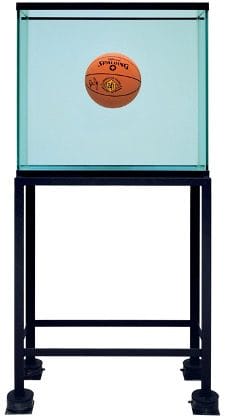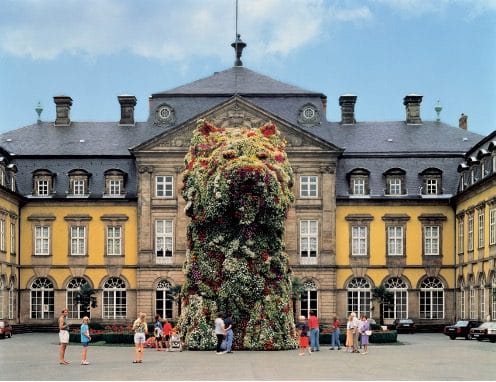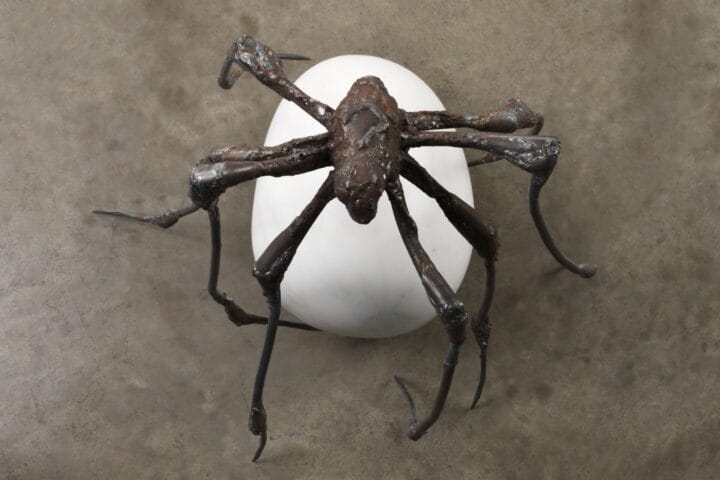New York, April 27, 2021 – Marc Glimcher, CEO and President of Pace Gallery, today announced that the gallery will begin representing Jeff Koons exclusively worldwide.
Jeff Koons is among the world’s most influential and iconoclastic living artists. Koons has become internationally renowned for his sculptures and paintings that explore meaning in our media-saturated age. Marrying rigorous conceptualism with commercial aesthetics, and spectacular displays with an unparalleled degree of technical finesse, Koons has repeatedly tested the limits of both fabrication and art history, simultaneously redefining Minimalism and Pop Art. His Inflatables, which apply Duchamp’s concept of the “readymade” to objects, rendered in stainless steel and often enlarged to monumental scale, have become emblems of our contemporary era. The mirrored finishes of sculptures such as Rabbit (1986) and Balloon Dog (1994–2000), as well as the more recent Gazing Ball series (2012–21), create opportunities for affirmation through literal self-reflection. These shiny, brightly colored surfaces extend to Koons’s photorealistic paintings, their fusion of pop and art historical references achieving his stated aim to “communicate with the masses.” Transcending time and geography, high and low culture, Koons’s art imparts a visual experience of the sublime.
Pace has always engaged with artists who, like Koons, possess original vision, from 20th-century greats who comprise the gallery’s foundational program such as Calder, Agnes Martin, and Mark Rothko, to contemporary luminaries Sam Gilliam, David Hockney, Maya Lin, Adam Pendleton, James Turrell, and Yoshitomo Nara, who—similarly to Koons— uses imagery from pop culture to reflect on the individual’s sense of self and place in the broader cultural narrative. Koons’s oeuvre also expands on the legacy of Pace artists Claes Oldenburg and Coosje van Bruggen, whose playful and colossal sculptures are created from a visual lexicon drawn from everyday life.

Marc Glimcher comments:
“Jeff Koons’s contribution needs no introduction. Jeff changed the way we see the world around us and the way we understand our culture and ourselves. He perceived a cultural shift decades before any of us knew it was underway by propelling through the barrier of elitism that was ringfencing the art world. We are excited to support Jeff by exploring his potential together in new ways, and we are proud and privileged to represent him at Pace Gallery.”
Jeff Koons comments:
“Sometimes professionally in life we can find ourselves at a crossroads. Going through the last year or so and having the opportunity to reflect on what I would like to achieve with my life’s work in order to bring it to its fullest potential, I have decided that a change in the environment in which my work is viewed and supported would be a positive thing at this time. I have known Marc for decades and I’ve decided that Pace Gallery feels like an exciting situation for me and my work. The most important thing to me is the production of my work and to see these artworks realized so that they can be exhibited and viewed. I think this new change in my life with Pace Gallery will bring about tremendous opportunities for my work.”
Pace’s first collaboration with Koons will be an exhibition of a single seminal sculpture at the gallery’s Palo Alto space in 2022. In 2023, Pace will stage a major exhibition at its flagship gallery in New York devoted to a new body of work from Koons that has been years in the making.
On May 5, Koons will open Jeff Koons Mucem: Works from the Pinault Collection at Mucem, the Museum of European and Mediterranean Civilizations, in Marseille, France. 19 works on loan from the Pinault Collection will span Koons’s career, from Balloon Dog to the Gazing Ball and Antiquity series. In fall 2021, Jeff Koons. Shine will open at the Palazzo Strozzi in Florence, Italy, exploring Koons’s reference to philosophy using shiny, reflective surfaces, from the late 1970s to the present day. Qatar Museums will present Jeff Koons: Lost in America at QM Gallery ALRIWAQ in Doha, Qatar this November 2021. In summer 2022, Koons will stage an exhibition at the DESTE Foundation Project Space, a historic slaughterhouse in Hydra, Greece. The project will be on view from June 21 to September 30, 2022.

About the Artist
Jeff Koons was born in York, Pennsylvania in 1955. He exhibited a passion for art at an early age. When he was nine, his father Henry, an interior designer, placed Old Master paintings that Koons had copied in the window of his furniture store to promote his son’s artwork. Koons went to Maryland Institute College of Art in Baltimore and through a student mobility program studied at the School of the Art Institute of Chicago under Ed Paschke, whose technicolor renderings of superheroes and other pop icons were an early source of inspiration. Koons received a BFA from Maryland Institute of College of Art in 1976.
After moving to New York City in the beginning of 1977, Koons’s first job was at the Museum of Modern Art, where he worked several years until he began working as a Wall Street commodities broker to support his studio practice. His first major works invoked commodity fetishism: titled The New, they comprised vacuum cleaners displayed on or in Plexiglas boxes over grids of fluorescent light. Exhibited for the first time in the window of the New Museum in New York in 1980, they were glossy reliquaries of American consumer culture that cemented Koons’s reputation as a rigorously conceptual artist.
In 1983, Koons began the Equilibrium series, suspending basketballs in aquarium tanks filled with water. Working with Nobel Prize-winning physicist Richard Feynman, he devised a precise mixture of water and salt that would make the balls float in the middle of the tanks, as if suspended. Koons’s interest in buoyancy was always within his inflatables, which would soon vault him to stratospheric fame: taking air-filled vinyl toys and casting them in polished stainless steel, he once again transformed a cheaply manufactured commodity into a precious object, capable of reflecting a viewer’s desiring gaze. Over time, these sculptures grew in scale, from the modestly-sized Rabbit (1986) to the monumental Balloon Dog (1994–2000). In 2007, Rabbit floated more than 50 feet over New York’s Fifth Avenue, reimagined as a gigantic helium-filled balloon in the Macy’s Thanksgiving Day Parade.
In the mid-1980s, Koons cast for the first time sculptures in stainless steel, including the Jim Beam – J.B. Turner Train that was a liquor decanter set filled with Jim Beam bourbon and Kiepenkerl, a life-sized statue of a 17th-century traveling merchant, which Koons created for the 1987 edition of Skulptur Projekte Münster. For the Banality series, Koons changed his materials. He collaborated with workshops in Germany and Italy to produce larger-than-life-sized sculptures in porcelain and wood inspired by banal and dislocated images that we are surrounded by in our lives. Several of these sculptures, polychromed in bright colors, represented American pop icons such as Buster Keaton and Michael Jackson, cradling his chimpanzee Bubbles. Rendered to scale, they are simultaneously exuberant and unsettling.
Koons’s combining of rococo fantasy and pop kitsch reached its apotheosis in Made in Heaven (1989–91), a series of sculptures and paintings. The works were sensationally controversial for their graphic content and bold transgression of social norms. After Made in Heaven, Koons made his world-renowned Puppy sculpture made out of 60,000 live flowering plants, which was a continuation on the Baroque and Rococo tradition.
Inspired by the cycles of life within a calendar year, Koons embarked on the Celebration series in 1994, his most ambitious and technologically demanding work yet. While completing the complex Celebration sculptures, Koons turned his attention to oil painting, a medium in which he has continued to work ever since. In the Easyfun and Easyfun-Ethereal series, culling images from magazines and product packaging, particularly those involving food and sex, Koons used computer software to create densely layered digital collages that he then transferred to canvas by hand in compositions. His engagement with pop culture extended to comic book characters, inflatable pool toys, and everyday life in the series Popeye (2002–13) and Hulk Elvis (2004–21).
Most recently, Koons has returned to the art of classical antiquity and the Renaissance. His Venus sculptures from the Antiquity series (2008–) in mirror-polished stainless steel, invoke the goddess of love and beauty–themes that recur throughout his work—while using mass-produced figurines as models. Koons’s Gazing Ball series (2012–21) embeds mirrored orbs into reproductions of Old Master paintings, offering viewers a chance to experience a metaphysical state within time and space contained within these great works of art and our relationship to them and the artist.
Pace is a leading international art gallery representing some of the most influential contemporary artists and estates from the past century, holding decades-long relationships with Alexander Calder, Jean Dubuffet, Barbara Hepworth, Agnes Martin, Louise Nevelson, and Mark Rothko. Pace enjoys a unique U.S. heritage spanning East and West coasts through its early support of artists central to the Abstract Expressionist and Light and Space movements.
Since its founding by Arne Glimcher in 1960, Pace has developed a distinguished legacy as an artist-first gallery that mounts seminal historical and contemporary exhibitions. Under the current leadership of President and CEO Marc Glimcher, Pace continues to support its artists and share their visionary work with audiences worldwide by remaining at the forefront of innovation. Now in its seventh decade, the gallery advances its mission through a robust global program—comprising exhibitions, artist projects, public installations, institutional collaborations, performances, and interdisciplinary projects. Pace has a legacy in art bookmaking and has published over five hundred titles in close collaboration with artists, with a focus on original scholarship and on introducing new voices to the art historical
canon. The gallery has also spearheaded exploration into the intersection of art and technology through new business models, exhibition interpretation tools, and representation of artists engaging with technology.
Today, Pace has nine locations worldwide including London, Geneva, a strong foothold in Palo Alto, and two galleries in New York—its headquarters at 540 West 25th Street, which welcomed almost 120,000 visitors and programmed 20 shows in its first six months and an adjacent 8,000 sq. ft. exhibition space at 510 West 25th Street. Pace was one of the first international galleries to establish outposts in Asia, where it operates permanent gallery spaces in Hong Kong and Seoul, as well as an office and viewing room in Beijing. In 2020, Pace opened temporary exhibition spaces in East Hampton and Palm Beach, with continued programming on a seasonal basis. In fall 2021, Pace will continue to expand its European presence with the opening of a larger gallery space in London.










